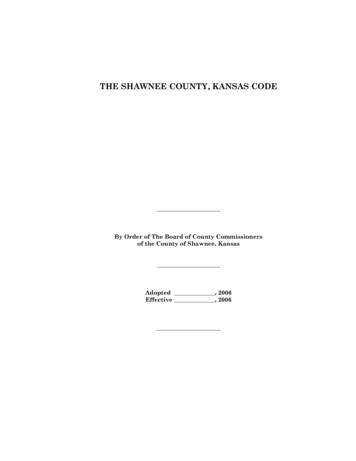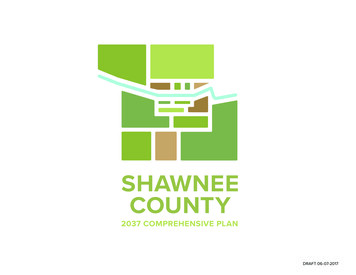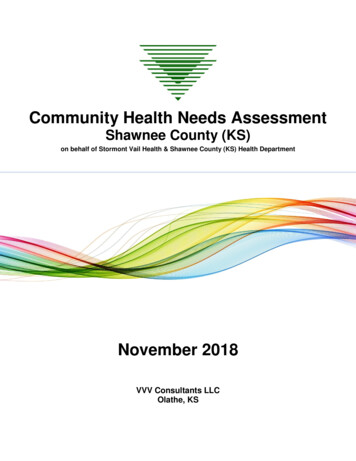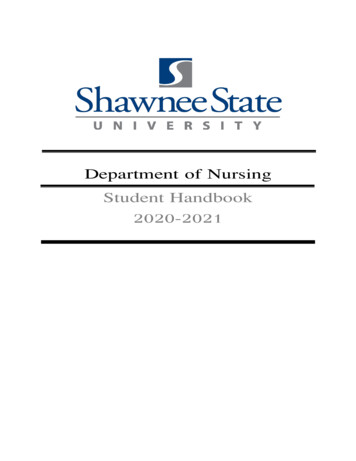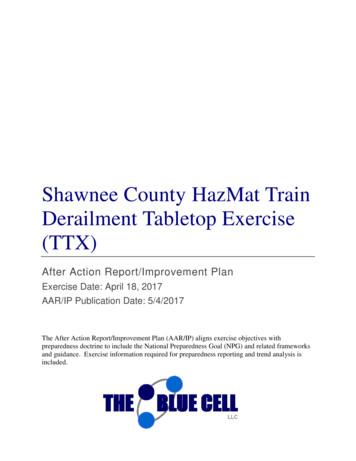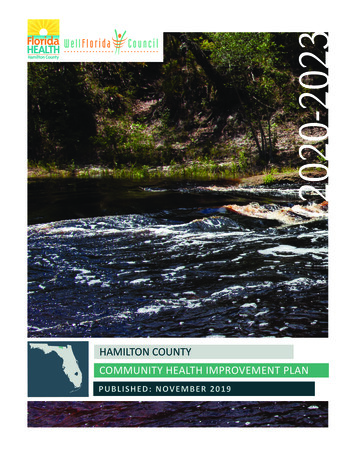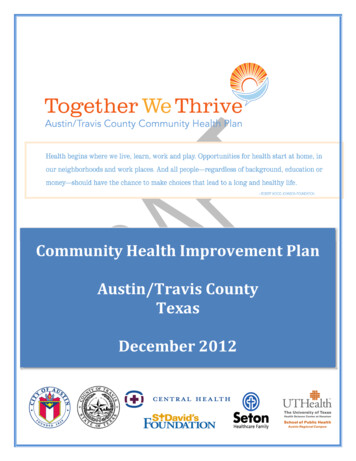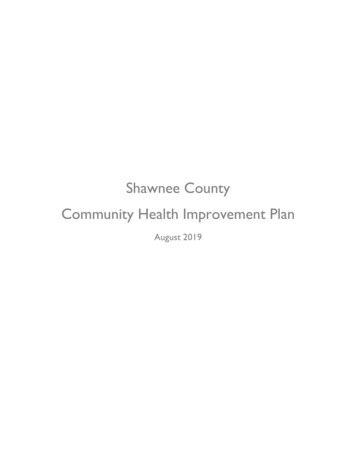
Transcription
Shawnee CountyCommunity Health Improvement PlanAugust 2019
Shawnee CountyCommunity Health Improvement PlanTABLE OF CONTENTSCREDITS AND ACKNOWLEDGMENTS . iiEXECUTIVE SUMMARY . iiiPART 1: BACKGROUND INFORMATION . 1CHA-CHIP Process . 2PART 2: PRIORITY AREAS . 8Behavioral Health. 8Safe Access to Food . 12Substance Use . 15Health Equity. 21PART 3: SUMMARY AND NEXT STEPS . 25Appendix A – Partner Organizations Involved in CHIP Prioritization . 26Appendix B - Glossary . 1Appendix C – CHNA Tables. 3Appendix D – HHN Structure . 6Heartland Healthy NeighborhoodsShawnee County CHIP i
CREDITS AND ACKNOWLEDGMENTSShawnee County Community Health Improvement PlanAugust 2019Prepared by:CHIP Steering CommitteeCraig BarnesShawnee County Health Department and Chair of Heartland Healthy NeighborhoodsVirginia Barnes, M.P.H.Blue Cross Blue Shield of Kansas and Past Chair of Heartland Healthy NeighborhoodsSusan Caman, M.P.H., C.H.E.S.Shawnee County Health Department and Heartland Healthy NeighborhoodsAustin Jackson, Ph.D.Stormont Vail HealthEnedina Patch, M.B.A., B.S.N., R.N.Stormont Vail Health and Vice Chair of Heartland Healthy NeighborhoodsAcknowledgmentsFunding for this Community Health Improvement Plan (CHIP) comes from the Topeka CommunityFoundation and the Kansas Health Foundation. The Community Health Needs Assessment (CHNA) wasfunded by Stormont Vail Health. Thanks to Steve Corbett and Sarah Hartsig, consultants from theKansas Health Institute for their expertise and assistance in developing this CHIP. We would also like tothank members of the community who contributed their time and talent to identifying the priorities andintervention strategies included in this CHIP. A full list of community organizations with members whoparticipated in prioritization can be found in Appendix A. We especially would like to thank those whohave been, and who will be, involved in implementing the strategies laid out in this CHIP.Heartland Healthy NeighborhoodsShawnee County CHIP ii
Letter from Craig Barnes, Chair of Heartland Healthy NeighborhoodsDear Community Partners,On behalf of Heartland Healthy Neighborhoods (HHN), I am extremely excited to share with youShawnee County’s 2020-2022 Community Health Improvement Plan (CHIP). The 2020-2022 CHIP is acollective, community-driven effort, and so many of you were an integral part of its development. Thisiteration of the CHIP embodies the concept of “Upstream Health.” An upstream approach to healthchallenges us to think critically about the social determinants of heath, and utilizes policies, systems andenvironmental changes to create an environment in which every resident in Topeka and ShawneeCounty has the ability to live a healthy life. with a focus on health equity and the ability to foster strongcommunity collaboration to ensure that we are able to create an environment in Topeka and ShawneeCounty where every resident has the ability to live a healthy life regardless of their education, incomelevel or ZIP code.Improving the health of our community is not just the role of any one entity or individual; it requirescollaboration, time, investment and commitment. It takes an upstream approach to look at sustainablechanges to policies, systems and the environment. It requires us to be innovative, adaptive and forwardthinking. It requires us to “get comfortable with the uncomfortable.” Most of all, it takes an entirecommunity working together to improve the overall health and quality of life of its citizens.Addressing the social determinants of health is complex, and in order to see sustainable and effectiveimprovement, we cannot afford to work in silos. Collaboration is paramount, and by working togetherwe can accomplish more positive impacts on health outcomes then from organizations workingseparately on parallel pathways. It is our hope the 2020-2022 CHIP will serve as a platform fordeveloping collective impact principles focused on priorities that were determined through acomprehensive assessment process; and ultimately, provide our community with a strategic roadmap toeliminating health disparities and improving health outcomes.Great things are already happening in our community that focus on improving the quality of life andplace in Shawnee County. We have HHN, the community’s only grassroots health coalition that bringstogether community members and organizations to implement health strategies and interventions. Wehave Momentum 2022, a holistic economic development plan that recognizes health is a key indicator inthe economic viability of our community. We have a County Commission and a City Council that havebeen supportive of policies, systems and environmental changes that positively impact the health of ourcommunity. However, there is still so much more that we can achieve as a community.I encourage you to review the priorities and goals of the CHIP; reflect on the strategies outlined, andconsider how you can join us in growing a culture of health for our community – whether that beindividually, with your organization, or collectively as a community. Together, we can make Topeka andShawnee County the best place to live, learn, work and play!Sincerely,[Insert Signature Here]Heartland Healthy NeighborhoodsShawnee County CHIP iii
Craig BarnesChair, Heartland Healthy NeighborhoodsHeartland Healthy NeighborhoodsShawnee County CHIP iv
EXECUTIVE SUMMARYSince the development of the 2015 Community Health Improvement Plan (CHIP), Heartland HealthyNeighborhoods (HHN) has led the CHIP efforts for the Topeka-Shawnee County community. The CHIPSteering Committee, consisting of HHN’s Current Chair, Vice-Chair, Immediate Past Chair, CommunityHealth Planner and the Director of Strategy and Business Development for Stormont Vail Health, hasspearheaded the development process of the most recent iteration of the CHIP with assistance fromtwo consultants from the Kansas Health Institute.In 2018, Stormont Vail Health in collaboration with the Shawnee County Health Department hired VVVConsultants LLC to perform the Community Health Needs Assessment (CHNA), which serves toinform the CHIP. The CHNA included a community health needs assessment survey that returned over2,300 responses; the compilation of secondary data on the health outcomes and healthcare deliveryservices in the county; and several town hall meetings where attendees were given the opportunity toprovide input on what they perceived as the top health issues for the county. A list of selected tablesfrom the CHNA can be found in Appendix C.Based on the results of the CHNA activities, a list of potential health priority areas was created. Thesepotential priority areas were prioritized, engaging over 100 community members at two communitymeetings to select the priorities using five criteria: seriousness, feasibility, alignment, measurability andconcern. As a result, four health priority areas were identified: 1) Behavioral Health, 2) Safe Access toFood, 3) Substance Use and 4) Health Equity.CHIP Workgroups were created for each priority area from existing community organizations, HHNworkgroups and other community stakeholders. This CHIP aims to break down silos betweenorganizations and maximize the collective impact of the groups as they engage in CHIP and non-CHIPactivities. By collaborating with existing organizations, HHN aims to build community capacity to ensuresustainability of CHIP and non-CHIP activities.Goals and objectives, including the target measures for the objectives within each priority area, weredrafted by the CHIP Steering Committee and refined based on feedback from the CHIP workgroups andother community stakeholders. Goals and objectives for each priority area can be found in Figure E-1(page vii).Interventions and activities to be undertaken were developed by the HHN Workgroups and partneringorganizations for each priority area, in consultation with the CHIP Steering Committee. Theinterventions chosen to achieve the objectives in this CHIP address areas of both midstream andupstream health. That is, the CHIP includes interventions that address individual social needs, as well asimproving community conditions that will support healthier lives for all Shawnee County residents.Throughout the development of the CHIP, the steering committee considered upstream solutions thatincluded policy, systems and environmental (PSE) changes to address the social determinants of healthfor each of the priority areas. They also recognize the importance of health equity in community changeand will include an ongoing focus on social determinants, PSE and health equity as implementation movesforward.Heartland Healthy NeighborhoodsShawnee County CHIP v
Figure E-1. CHIP Priority Areas, Goals and ObjectivesPRIORITY AREA 1: BEHAVIORAL HEALTHGOAL 1.1: Decrease suicides in Shawnee County.Objective 1.1.1: Decrease suicide rate from 23.5/100k to 21.4/100k by 2022.GOAL 1.2: Create an integrated system of care to address crisis through recovery andprevention.Objective 1.2.1: Decrease behavioral-related hospital admission rate from 110.2/10k to 103.3/10k.Objective 1.2.2: Reduce poor mental health days from 3.4/30 days to 3.2/30 days.Objective 1.2.3: Stabilize depression in the Medicare population at 25.3% or lower.PRIORITY AREA 2: SAFE ACCESS TO FOODGOAL 2.1: Reduce food insecurity and food deserts in Shawnee County.Objective 2.1.1: Reduce overall food insecurity rate from 13.3% to 12.0% by 2022.Objective 2.1.2: Reduce child food insecurity rate from 18.4% to 17.4% by 2022.Objective 2.1.3: Decrease the number of census tracts listed as “food deserts” by the USDA from 9 to 8 by2024.PRIORITY AREA 3: SUBSTANCE USEGOAL 3.1: Decrease the use of alcohol and tobacco products among Shawnee Countyyouth.Objective 3.1.1: Decrease the percentage of youth who smoked cigarettes during the last 30 days from 2.44%to 2.0% by 2022.Objective 3.1.2: Decrease the number of youth reporting binge drinking episodes from 7.42 times in the last15 days to 6.5 times in the last 15 days by 2022.Objective 3.1.3: Stabilize 30-day e-cigarette use at 11.93% or lower.GOAL 3.2: Decrease overdose and drug poisoning deaths among Shawnee Countyresidents.Objective 3.2.1: Decrease drug poisoning deaths from 15.9/100k to 14.5/100k by 2022.PRIORITY AREA 4: HEALTH EQUITYGOAL 4.1: Improve maternal, infant and child health outcomes in Shawnee County.Objective 4.1.1: Increase the percent of women in Shawnee County receiving prenatal care in the firsttrimester from 78.7% to 80% by 2022.Objective 4.1.2: Decrease the infant mortality rate from 7.8/1,000 to 6.8/1,000 by 2022.GOAL 4.2: Decrease STIs among Shawnee County residents.Objective 4.2.1: Decrease the STI rate from 10.0/1,000 to 8.5/1,000 by 2022.GOAL 4.3: Decrease obesity among Shawnee County residents.Objective 4.3.1: Decrease the percent of adults who are obese from 36.2% to 34% 2022.Heartland Healthy NeighborhoodsShawnee County CHIP vi
PART 1: BACKGROUND INFORMATIONThe Shawnee County CHIP covers the entire population of Shawnee County. Located in northeasternKansas (Figure 1), Shawnee County has a total population of 177,499 people (U.S. Census Bureau,2018). Topeka, the state capital and the county seat, has a population of 125,904.Figure 1. Location of Shawnee County in Northeastern Kansas.Shawnee County has slightly greater racial and ethnic diversity than the State of Kansas overall. Over 26percent of the county is made up of non-whites (Figure 2, page 2), which tend to show higher levels ofpoverty than whites.1 Median and per capita income are slightly lower for Shawnee County than for thestate as a whole. The County’s poverty rate is 11.7 percent.2 The percentage of Shawnee Countychildren living in poverty is 15 percent, and 31 percent of children live in single-parent households.3U.S. Census Bureau American Fact Finder jsf/pages/productview.xhtml?src CFU.S. Census Bureau QuickFacts eecountykansas/RHI125218#RHI1252183 County Health Rankings and /snapshot12Heartland Healthy NeighborhoodsShawnee County CHIP 1
Figure 2. Racial/Ethnic Makeup of Shawnee County Citizens, and Poverty Levels.Shawnee County mericanAsianAmerican Indian/Alaska NativeNative Hawaiian/Pacific IslanderOtherPercent73.712.68.51.61.40.12.1Percent below Poverty9.923.623.211.418.238.8 22Source: U.S. Census Bureau QuickFacts eecountykansas/RHI125218#RHI125218; U.S.Census Bureau American Fact Finder jsf/pages/productview.xhtml?src CFCHNA-CHIP ProcessAs of 2019, Shawnee County has conducted three rounds of Community Health NeedsAssessments (CHNA)4. The first was conducted in 2012, and since then, a CHNA has beencompleted every three years (2012, 2015, 2018), in accordance with IRS requirements for non-profithospitals. The first Community Health Improvement Plan (CHIP) was developed in 2015. Sincethe development of the 2015 Shawnee County CHIP, Heartland Healthy Neighborhoods (HHN) has ledthe CHIP efforts for the Topeka-Shawnee County community.HHN is a community coalition in Topeka and Shawnee County that was formed in 2008 and whosemission is to: “mobilize the community to take action on health priorities so that policy, environment, andpractice influences a culture shift toward health and wellness for everyone in Shawnee County.” HHN continuesto provide leadership for the Community Health Improvement Plan and was integral in the developmentof the current plan. The CHIP Steering Committee, consisting of HHN’s Current Chair, Vice-Chair,Immediate Past Chair, Community Health Planner and a representative from Stormont Vail Health, hasspearheaded the development process of the most recent iteration of the CHIP with assistance fromtwo consultants from the Kansas Health Institute. Going forward, the CHIP Steering Committee willoversee the implementation, evaluation and reporting of the CHIP alongside HHN leadership, HHNworkgroups and partnering organizations. In addition to the positions listed above, the CHIP SteeringCommittee will seek participation and engagement from workgroup chairs, representatives frompartnering organizations and other interested community stakeholders.For the current round of community health assessment and improvement planning, a consultant (VVVConsultants LLC), was hired by Stormont Vail Health to conduct the CHNA. The CHNA processconsisted of:1) A Community Health Needs Assessments (CHNA) community survey, which wasdistributed in the summer of 2018. The survey received over 2,300 responses throughoutthe community. See Figure 3 (page 3) for a summary of results from the survey.4 A glossary of the bolded terms can be found in Appendix B.Heartland Healthy NeighborhoodsShawnee County CHIP 2
Figure 3. Top issues from CHNA Community Survey, 2018Shawnee County, Kansas – CHNA Community Survey, 2018In general, how big of a problem are the following healthcareissues in our community? (respondents were able to selectmore than one answer)IssueMental health issuesOverweight/obesityAlcohol/drug abuseNot eating healthyLack of exerciseOpioid abuse/dependenceDiabetesTobacco useHeart disease/strokeKnowledge of available servicesOral/dental healthAccess to primary healthcareTransportation to healthcare servicesCancerLung, respiratory illnessArthritis, joint/back painTeen pregnancyInfant mortalityInfant immunizationsShawnee County 2018 CHNA Survey(N 2,324)# 2.9%12.4%10.9%7.3%6.9%Source: Shawnee County CHNA, 20182) Compilation of secondary data about health outcomes and healthcare delivery services inthe county, including County Health Rankings and other measures of morbidity and mortality. As ofApril 2019, Shawnee County is ranked 59th for Health Factors, and 79th for Health Outcomes out of 102ranked counties in Kansas. Years of Potential Life Lost (YPLL) from mortality due to chronicdiseases, drug overdoses and suicide, is a measure from the County Health Rankings that contributesmost to lowering Shawnee County’s ranking.3) Town halls across the county to share and discuss the survey and data. During the townhalls, participants were given the chance to provide input on what they perceived to be the top healthissues for Shawnee County. That list of issues is what was used for prioritization of issues for the CHIP.See Figure 4 (page 4) for a list of the top issues from the town hall meetings.Heartland Healthy NeighborhoodsShawnee County CHIP 3
Figure 4. Shawnee County Town Hall Top Issues, 2018Shawnee County, Kansas – CHNA Town Hall Meeting, 2018#Community Health Issue12345678Access to mental health (diagnosis, treatment, placement, crisis)Improve health literacySafe access to healthy foodSingle family households in poverty supportSex education (me too, consent)Affordable health insuranceCare coordinationState ID easier to get# Votes(172 total)3819141411111111% of votes22.1%11.0%8.1%8.1%6.4%6.4%6.4%6.4%Source: Shawnee County CHNA, 2018Note: The total of 172 votes includes votes for other issues which were not included in the list of top issues.A list of the top issues from the CHNA community survey and the list of top issues from the town hallswere combined and used for prioritization of issues for the CHIP. The top issues from the CHNAsurvey and CHNA town halls were evaluated against the following criteria: Seriousness – How much of an impact does the potential priority area have on the morbidity,mortality and quality of life in the community?Feasibility – How likely is it that the CHIP can have an impact on the potential priority area?Alignment – How well does the potential priority area support other efforts in the community?Measurability – Is it possible to measure progress in the potential priority area?Concern – What is the level of concern in the community regarding the potential priority area?Participants at two community meetings, held on March 29, 2019, and April 8, 2019, representing over100 community voices, completed the prioritization process. For each issue in the list, they wereinstructed to judge the issue against the five criteria and rate the issue from 1 (lowest) to 5 (highest) foreach of the criteria. The results of this prioritization process can be found in Figure 5 (page 5).Heartland Healthy NeighborhoodsShawnee County CHIP 4
Figure 5. Priority Area Scoring MatrixPriority Area Scoring MatrixPRIORITY ncernSCORERANKAccess to Mental Health 20.32Safe Access to Healthy Food4.23.94.13.83.920.03Substance Abuse4.13.63.63.63.918.94Affordable Health Insurance4.23.23.23.83.818.35Preventive Services3.83.73.73.73.318.26Education to Under Privileged4.03.53.63.73.318.07Affordable Housing4.03.33.43.73.617.98Single Family Households inPoverty Support4.13.33.43.63.517.99Sex Education/Family Planning3.83.83.43.63.317.810Newborn follow-up visits3.63.73.44.03.117.811Child Care Options3.83.33.23.53.317.112Improve Health Literacy3.53.53.43.33.116.813Care Coordination3.23.53.23.53.116.514Access to Public 3.52.916.316State ID (easier to get)2.93.73.13.72.716.017Keeping population at home afterhigh school2.82.73.03.43.014.818Using the results from that prioritization process, four issues rose to the top as priorities to focus onduring the CHIP Process. the CHIP Steering Committee summarized the top vote-getters into thefollowing four priority areas:1.2.3.4.Behavioral HealthSafe Access to FoodSubstance UseHealth EquityCHIP workgroups for each priority area were created from existing community organizations,stakeholders and HHN workgroups. A schematic diagram of the workgroups involved in each priorityarea can be found in Appendix D. This CHIP aims to break down silos between organizations andmaximize the collective impact of the groups as they engage in CHIP and non-CHIP activities. Bycollaborating with existing organizations, HHN leadership also aims to build their capacity andsustainability. The CHIP Steering Committee developed the goals and sought feedback from theWorkgroups and other community partners on the content of these priority areas and goals.Heartland Healthy NeighborhoodsShawnee County CHIP 5
Objectives for each priority area were drafted by the CHIP Steering Committee and refined based onfeedback from the CHIP workgroups. Targets for the outcome objectives were determined byexamining trends over time in changes to the measures in order to create feasible outcome objectiveswithin the given timeframe. The degree of change from year-to-year was used to establish a reasonableestimate of change in the measures by the year 2022. Additionally, the group considered that HealthyPeople 2020 objectives typically aim for a 10 percent improvement over the course of 10 years. Becausethis CHIP covers a span of three years, expectations were adjusted accordingly. The benchmarkingagainst HP 2020 targets provided a general estimate, while the trend analysis (if available) provided morespecificity to the local measures and changes over time.Once the priority areas, goals and objectives were finalized, interventions and activities to beundertaken were developed by the workgroups and partnering organizations for each priority area, inconsultation with the CHIP Steering Committee. The interventions chosen to achieve the objectives inthis CHIP address areas of both midstream and upstream health. That is, the CHIP includesinterventions that address individual social needs, as well as improving community conditions that willsupport healthier lives for all Shawnee County residents.Throughout the development of the CHIP, the steering committee considered upstream solutions thataddressed the social determinants of health in each of the priority areas. See Figure 6 (page 7) for adescription of the social determinants of health. These are the factors in which people live, work, learnand play, and they all have strong impacts on how healthy we are.Figure 6: Social Determinants of HealthHeartland Healthy NeighborhoodsShawnee County CHIP 6
Source: Kaiser Family Foundation, 2018In order to make changes in the social determinants, the CHIP steering committee prioritized policy,systems and environmental (PSE) changes that fall on the lowest two tiers of the Health ImpactPyramid (Figure 7). They also recognize the importance of health equity in community change and willinclude an ongoing focus on social determinants, PSE and health equity as implementation movesforward.Figure 7: Health Impact PyramidIncreasing populationCounselingand EducationimpactIncreasing individualeffort neededClinicalInterventionsLong-Lasting ProtectiveInterventionsChanging the context to makeIndividuals' Default Decisions HealthySocioeconomic FactorsSource: Frieden, 2010The following sections provide detail on the goals, objectives and strategies for each priority area.Heartland Healthy NeighborhoodsShawnee County CHIP 7
PART 2: PRIORITY AREASBehavioral HealthGood mental health is critical to personal well-being, family and interpersonal relationships, and theability to contribute to the community or society. Behavioral health refers to the ability of citizens toutilize behavioral health services when they are needed. This incorporates whether the right servicesare available and if there is an adequate supply of services to meet demand. It also includes theaffordability, physical and geographic availability, and quality of services to ensure positive healthoutcomes from the services.5Recent data suggest lack of behavioral health services is a primary cause of the growing mental healthcrisis in the U.S., with costs, social stigma and lack of knowledge on where to find services cited asmajor barriers to access6. From 1999 to 2017, the suicide rate in the U.S. increased 33 percent.7 It hasshown an upward trend for both sexes between 1981 and 2016 (Figure 8).Figure 8. Crude suicide rate in the United States, 1981–2016.8Source: CDC WISQARS Fatal Injury Reports.Gulliford, M., Figueroa-Munoz, J., Morgan, M., Hughes, D., Gibson, B., Beech, R., & Hudson, M. (2002). What does “access tohealth care” mean? Journal of Health Services Research & Policy, 7(3), 186–188. https://doi.org/10.1258/1355819027600825176 Wood, P., Burwell, J., & Rawlett, K. (2018). America’s Mental Health 2018. Cohen Veterans Network and National Councilfor Behavioral Health Retrieved July 2, 2018 from lHealth/7 Hedegaard, H., Curtin, S.C., & Warner, M. (2018). Suicide mortality in the United States, 1999–2017. NCHS Data Brief, no330. Hyattsville, MD: National Center for Health Statistics. 2018.8 CDC WISQARS Fatal Injury Reports. 5Heartland Healthy NeighborhoodsShawnee County CHIP 8
Why is behavioral health a concern for Shawnee County?According to the 2019 County Health Rankings, Shawnee County residents reported more poor mentalhealth days (3.5) than the statewide average (3.3).9 As a part of the community health needs assessment(CHNA), access to mental health services (diagnosis, treatment, placement crisis) received the highestpercentage of votes (22.1%) of any community health need to change or improve at the communitytown hall vote (Figure 4, page 4). Access to mental health services was identified in the previousCHNA, and in 2018 voted the No. 1 ongoing problem with 10.3% of all votes (see Figure C-2, AppendixC). Over 48% rated mental health services “poor” or “very poor” (Figure C-3, Appendix C). Access tomental health services was also voted as the No. 1 priority at stakeholder meetings (Figure 5, page 5).Higher suicide rates are a potential adverse outcome resulting from a of lack of access to behavioralhealth services. Suicide is a significant contributor to Shawnee County’s increase in years of potentiallife lost. Shawnee County’s suicide death rate per 100,000 population rose from 15.9 in 2014 to 23.7 in2017, an increase of 49 percent, and has been steadily rising since 2009-2011 (Figure 9, page 11). Ratesfor depression and suicide are both higher for Shawnee County than for the state of Kansas as a whole(Appendix C, Figure C-4). Suicide was voted as the No. 2 priority at the stakeholder meetings, behindaccess to mental health services.Figure 9. Age-adjusted suicides in Shawnee County, 2000-2017.County Health Rankings, apshot.9Heartland Healthy NeighborhoodsShawnee County CHIP 9
Age-Adjusted Suicide Mortality Rate per 100,000Shawnee County, rce: Kansas Health Matters, 2019What are our goals and how do they align with state and national goals?PRIORITY AREA 1: BEHAVIORAL HEALTHShawnee County GoalsHealthy Kansans2020 GoalsGoal 1.1: Decrease Suicides inShawnee County.NAGoal 1.2: Create an integratedsystem of care to addresscrisis through recovery andprevention.Promote Integrated HealthCare Delivery, IncludingIntegrated Behavioral Health,Social Services and MedicalCareHealthy People 2020 GoalMHMD-1 Reduce the SuicideRate10.2/100,000; 21.5% decrease2014-2020.Improve mental health throughpreventionand by ensuring access toappropriate, qualitymental health services.Goals, Objectives, and Intervention StrategiesHeartland Healthy NeighborhoodsShawnee County CHIP 10
PRIORITY AREA 1: BEHAVIORAL HEALTHGOAL 1.1: Decrease Suicides in Shawnee County.Objective 1.1.1: Decrease suicide rate from 23.5/100k to 21.4/100k by 2022. (KDHE 2015-2017)Additional measure(s): Publicly available Shawnee County coroner’s data on suicides.Intervention strategy 1.1.a: Partner with the Suicide Prevention Coalition to work with middle schools toimplement Youth Resiliency presentations aimed at increasing coping skills for at-risk youth.Interven
Kansas (Figure 1), Shawnee County has a total population of 177,499 people (U.S. Census Bureau, 2018). Topeka, the state capital and the county seat, has a population of 125,904. Figure 1. Location of Shawnee County in Northeastern Kansas. Shawnee County has slightly greater racial and ethnic diversity than the State of Kansas overall. Over 26
